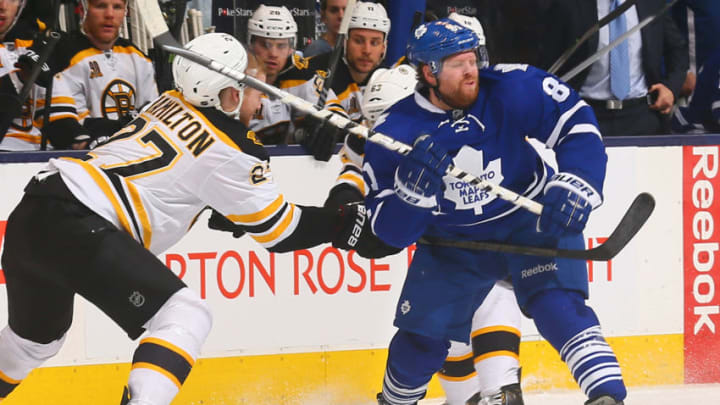We reach our first heavy hitter in the Toronto Maple Leafs trade history with our first Original Six team.
With a mutual history spanning the course of 96 years, the Toronto Maple Leafs and Boston Bruins have had ample opportunity to make some notable trades.
Quite a bit of action was done prior to 1967 expansion with 25 transactions made between the clubs from 1924 to 1967, most of which the swapping of minor league players.
Post expansion is a much different story. In the 53 years since, Toronto and Boston have completed 13 deals, including just one in the past 10 years.
This, of course, is no surprise due to the ever-growing rivalry between the two clubs. In the original six era of the NHL, you were forced to make trades with your rivals. If you didn’t, you were limiting yourself to two or three trading partners. In modern NHL history, that isn’t an issue for teams. Most teams avoid trading in division outright, with the exception of some trade deadline rentals as we’ll see later in this article.
Still, despite the relative lack of activity over the history of these two rivals, it’s fascinating to see just how many trades made between the Leafs and the Bruins have turned out to be significant ones in the history of the franchises.
From pillars in net to great goal scorers and future Hall of Famers, this Toronto Maple Leafs trade history has it all.
The Most Recent Trade
Leafs Acquire: Joe Colborne, 2011 1st (Rickard Rakell), 2012 2nd (Mike Winther)
Bruins Acquire: Tomas Kaberle
At the 2011 trade deadline, the Toronto Maple Leafs finally pulled the trigger on the Tomas Kaberle trade. After much speculation, the pending unrestricted free agent waived his no-trade clause to be moved to the Bruins to help with their Cup run.
Kaberle was in the midst of another very solid season with Toronto, leading the defence in scoring with 38 points in 58 games at the time of his departure. As a pending UFA on a weak Leafs team, it made no sense to hold on to him and let him go in free agency.
Instead, Toronto was able to get one of Boston’s top prospects in Joe Colborne, a 2011 first, and a conditional 2012 second if Kaberle re-signed with the Bruins or if Boston made the Cup final.
The trade worked out wonderfully on the Boston side of things. After 24 games in the regular season with the Bruins in the top four, Kaberle dropped down to a bottom pairing role in the Stanley Cup playoffs and flourished. 11 points in 25 games tied him with Dennis Seidenberg for the team lead in playoff scoring on defence, despite playing nearly 12 minutes less a night.
The depth Kaberle gave the Bruins was significant in Boston’s run all the way to the Stanley Cup finals, where they upset the favoured Vancouver Canucks to win their first Stanley Cup since 1972.
Although Kaberle did not re-sign with Boston, signing with Carolina instead, just making the Stanley Cup meant the Leafs also received Boston’s 2012 second-round pick.
In terms of pure value coming out of a rental move at the deadline, Brian Burke and the Leafs were superb. They got the Bruins consensus top prospect, their upcoming first-round pick, AND a second-round pick for a player on an expiring deal. Now, what did the Leafs do with the assets they acquired? Not much at all.
We’ll begin with Colborne. Coming off of a strong two-season career at the University of Denver, the former 16th overall pick had struggled in his first pro season at the time of the trade. He saw his production go from under a half point-per-game with Providence to 0.8 PPG in his 20 game stint with the Marlies.
In the next two seasons, Colborne would remain with the Marlies for the most part, seeing his scoring slowly increase. In spot duty with the Leafs, he was hit or miss. In 2011-12, his five points in 10 games gave a positive indication of what could be to come. In the lockout-shortened 2012-13 season, he got just five NHL games where he went pointless.
That brings us up to the pivotal 2013-14 season, where needing waivers for the first time Colborne would have to remain on the Leafs roster. The Nonis run Maple Leafs decided he hadn’t done enough to earn the roster spot in the preseason, and not wanting to risk him being claimed via waivers, traded him to the Calgary Flames for a conditional fourth-round pick.
Colborne would enjoy three solid seasons in Calgary, peaking with 19 goals and 44 points in 2015-16 (which would’ve been second on the Leafs in the same season) before flopping in Colorado and finding himself out of hockey by 2018.
Though Colborne didn’t pan out, something that is bound to happen with some prospects, the Leafs simply wasted the picks they got in the trade.
For starters, Burke used the 30th overall pick to move up in the 2011 draft to select Tyler Biggs, a trade I already discussed in the Anaheim Ducks trade history.
As for the 2012 second, Toronto used that pick to acquire John-Michael Liles.
At the time of the trade, it looked like the Leafs clearly came out on top of the Kaberle deal. As the years have ticked away, it’s clear that Toronto didn’t capitalize on the assets they acquired. Even something as simple as holding on to the 30th overall pick and getting Rickard Rakell for themselves makes the trade a win for Toronto. Instead, the Bruins have the 2011 ring and the Toronto Maple Leafs have next to nothing to show from it.
